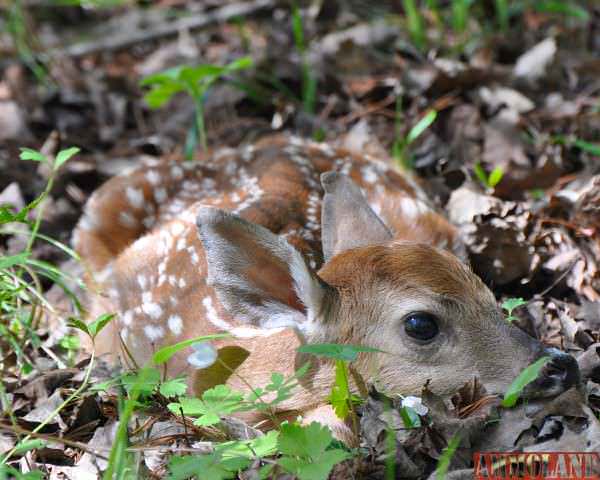Predators take their toll, but deer populations are stable or increasing.
by Pennsylvania Game Commission

Pennsylvania – -(Ammoland.com)-Three years of field study, 165 captured fawns and more than 200,000 trail-camera photos again have demonstrated that Pennsylvania has good, stable fawn survival.
The research, which wrapped up in 2017, was started to see if predators – particularly coyotes – were taking more fawns than documented in a two-year study that began in 2000. The Game Commission and Pennsylvania Cooperative Fish and Wildlife Research Unit at Penn State (PCFWRU) collaborated to design the study and conduct fieldwork.
Although the playing field had changed in the study areas when the second study began in 2015 – Pennsylvania had more predators and deer – the results essentially were the same, according to Christopher Rosenberry, who supervises the agency’s Deer and Elk Section.
“There was no evidence that predators were taking too many of our fawns in any of our 23 Wildlife Management Units,” Rosenberry said. “They all have stable or growing whitetail populations.”
“Our field studies have shown repeatedly that predators are the No. 1 cause of fawn mortality, and more often than not, black bears are taking the fawns,” Rosenberry said. “But fawn mortality is not causing deer-population reductions anywhere in Pennsylvania.”
Consistent fawn survival, coupled with consistent adult deer survival – 90 percent of adult deer survive from one hunting season to the next, has fostered straightforward deer management in Pennsylvania for some time, Rosenberry explained.
But even if the predator-take of fawns did impact deer populations, reductions in antlerless deer licenses would reverse their influence, Rosenberry noted.
The three principal predators that surfaced in the first study resurfaced in the second: black bears, coyotes and bobcats, said Duane Diefenbach, PCFWRU unit leader. Despite growing concern about fishers as deer predators, they didn’t take any fawns in the study. To date, no fisher has ever killed a radio-collared study fawn in North America, he noted.
In the 2015-17 study, 82 fawns were captured and fitted with radio collars on the northern study area on the Susquehannock State Forest. Another 83 fawns were captured and radio-collared on the southern study area, which included parts of the Rothrock and Bald Eagle state forests.
There were 44 mortalities on the northern study area: 33 from predators, six from humans and five from natural causes. Bears took 18 fawns; coyotes, eight; bobcats, two; and unknown predator, five.
The southern study area had 38 mortalities: 18 from predators, 13 natural causes and five from humans. Coyotes took six fawns; bears, five; bobcats, five; and unknown predator, two.
“Predation was the main source of mortality,” explained Tess Gingery, a Penn State graduate student with the PCFWRU. “It’s that way across North America.
“Since Pennsylvania’s fawn survival shows little change over time, this means that it’s stable and that makes it simpler for biologists to make harvest management recommendations,” she said.
Most fawn mortality occurred over the first eight weeks of a fawn’s life. Conversely, most human-caused mortality – roads, fences, farming activities and hunting – occurred in the 25- to 30-week window, Gingery said.
Natural mortality – starvation, disease, abandonment – was more pronounced on the southern study area in both the 2000-01 and 2015-17 studies.
Raccoons were detected more than 900 times by trail cams, said Asia Murphy, a Penn State graduate student with the PCFWRU. Bears – about 700 photos – were the most-detected major carnivore.
Interestingly, fawns – about 800 photos – were detected even more than bears, which sheds light on their mobility, as well as the closeness in which they live to carnivores.
Adult deer were detected at 97 percent of camera sites, and fawns at 44 percent. But considering bears were detected at 64 percent of camera sites, followed by coyotes, 36 percent, and bobcats, 33, it’s clear that fawns share habitat with major predators throughout much of their young lives.
Deer and bears prefer forested settings. But in the southern study area, many does summered in farm areas because it was safer for their fawns to reach a size in which they could escape predators, Murphy said. By the fall, fawns returned to forested areas.
“Does are smart,” Murphy said. “They raise their fawns in safe places.”
Does in Penn’s Valley followed the same routine in the earlier study.
Pennsylvania’s latest fawn survival study shows near identical fawn survival rates over the last two decades and corroborates the relatively stable fawn-to-doe ratios collected from annual deer harvests. Consequently, Pennsylvania’s predator impacts do not appear to changing, and if they would, the Game Commission’s has a system in place to respond, if needed.
 Whitetails over time have proven their capability to adjust to whatever advantage predators may gain by using behaviors to protect fawns. For example, in addition to using safer areas to raise fawns, does will spend time away from newborn fawns, only returning to feed a few times a day, so as to not attract the attention of predators. White-tailed deer remain one of the Commonwealth’s most versatile creatures. But they share that distinction with coyotes and bears, and that’s why there almost always will be concerns about the whitetail’s wellbeing among some hunters.
Whitetails over time have proven their capability to adjust to whatever advantage predators may gain by using behaviors to protect fawns. For example, in addition to using safer areas to raise fawns, does will spend time away from newborn fawns, only returning to feed a few times a day, so as to not attract the attention of predators. White-tailed deer remain one of the Commonwealth’s most versatile creatures. But they share that distinction with coyotes and bears, and that’s why there almost always will be concerns about the whitetail’s wellbeing among some hunters.
